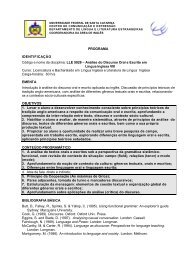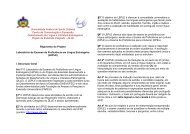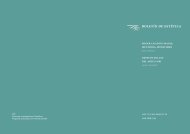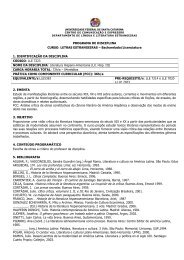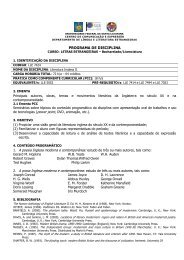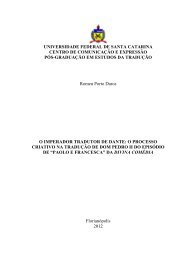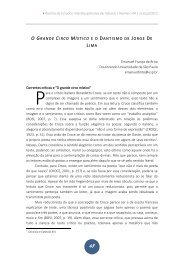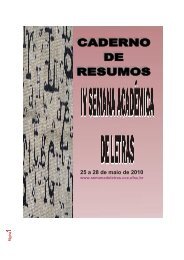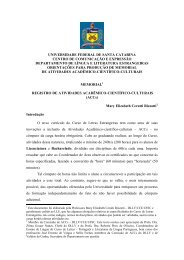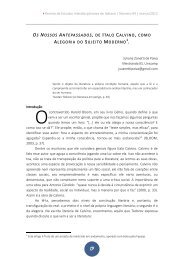Ana Amado é Professora de Análise Filmica e Teoria na ...
Ana Amado é Professora de Análise Filmica e Teoria na ...
Ana Amado é Professora de Análise Filmica e Teoria na ...
- No tags were found...
You also want an ePaper? Increase the reach of your titles
YUMPU automatically turns print PDFs into web optimized ePapers that Google loves.
eginning of the 80s reconstruct the youth of their parents through photos, letters, tapes,used clothing, stories and erased memories. Who were my parents when I was born?What was Argenti<strong>na</strong> like before I learned to talk? What versions exist about whathappened when I didn’t yet exist or was so little that I don’t remember? Each actor doesa remake of scenes from the past to un<strong>de</strong>rstand the future. As doubles for the risk oftheir parents, the children wear their clothing and try to present the family history....”On the bor<strong>de</strong>r between reality and fiction, in the encounter between two generations, the“literal” interpretation of scenes from the past perhaps points to a way to transform thefuture. But this “literalness” maintains a distance from verisimilitu<strong>de</strong> through a way oftalking without emphasis, lacking all emotio<strong>na</strong>l overtones, in which the words appear toflow with less fluidity than manipulating images (they use vi<strong>de</strong>o on direct takes, homemovies, photography) , playing instruments (they play the electric guitar, hum melodies,beat drums) or dancing or unbridled corporal play.As is the case of recent Argentine film by the children of the victims, Mi vida <strong>de</strong>spuéscon<strong>de</strong>nses the questions that come up in one work after another, in diverse forms ofexpression, about that time, about doubts and allegiances, about the abyss between thegenerations, about those perso<strong>na</strong>l histories that collectively make up history.This new type of Argentine film and theatre restores the collective dimension out of thefragments of individual, loving discourse that fi<strong>na</strong>lly takes its place as source anddocument for that dramatic span of history.<strong>A<strong>na</strong></strong> <strong>Amado</strong> is an Argentine essayist and film critic. She teaches Film <strong>A<strong>na</strong></strong>lysis andTheory at the Facultad <strong>de</strong> Filosofía y Letras of the Universidad <strong>de</strong> Buenos Aires.Formerly a visiting professor at Princeton and Duke Universities, she is author of thebook La imagen justa. Cine argentino y política (Ed. Colihue) , co-author of the Lazos<strong>de</strong> Familia. Herencias, cuerpos, ficciones (Editorial Paidos)and Espacios <strong>de</strong> Igualdad(Ed. Fempress) , as well as the author of numerous texts in books and magazines inArgenti<strong>na</strong> and abroad.______________________________________________________________________Em “A noção <strong>de</strong> representação da crise no nuevo cine argentino (1999-2004)”, Breno<strong>de</strong> Souza Juz, da UNICAMP, relembra que em artigo recente, apresentado <strong>na</strong> mostra <strong>de</strong>cinema argentino realizada pelo CINUSP, em agosto <strong>de</strong> 2002, <strong>A<strong>na</strong></strong> <strong>Amado</strong>, <strong>de</strong>senvolvea idéia <strong>de</strong> que os filmes do nuevo cine argentino apresentam-se esteticamente como“fábulas do mal-estar”. Apesar <strong>de</strong> mencio<strong>na</strong>r vários filmes que fazem parte da mostra, ocentro do argumento da autora está <strong>na</strong> análise do filme <strong>de</strong> Martel. Apesar <strong>de</strong> aparecer <strong>de</strong>modo sutil, a idéia do cinema argentino contemporâneo como produto da crise sócioeconômicavivida pelo país permeia o artigo, como se po<strong>de</strong> perceber no seguinte trecho:“Cinemas da ficção subjetiva, absolvida da obrigação documentária sobre omundo, mas com uma presença ao mesmo tempo avassaladora do documentárioem sua variante testemunhal, que ensaia códigos diretos para a representação dahistória, a memória e a realida<strong>de</strong> social. (...) a geração <strong>na</strong>scente <strong>de</strong> cineastas estáimpulsio<strong>na</strong>da a inventar novos dispositivos para seus relatos, capazes <strong>de</strong> captar<strong>na</strong>da ou quase <strong>na</strong>da. Consequência da crise que absorve tudo: corpos, figuras,



